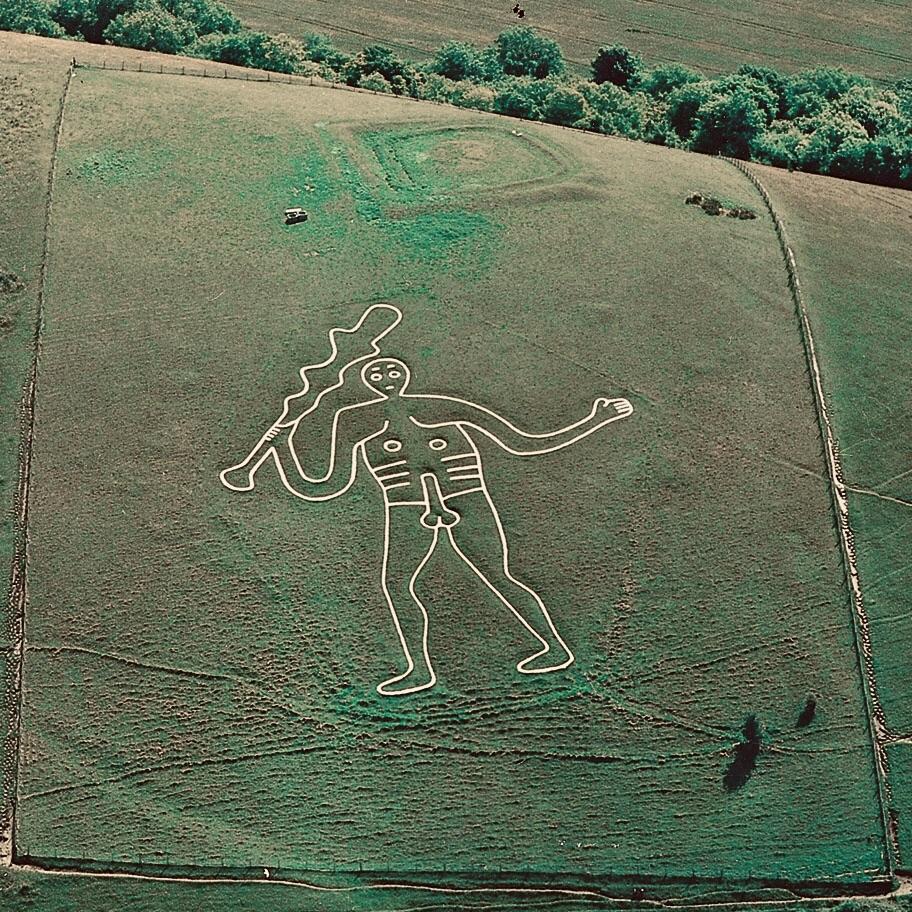The English Geoglyphs
The English geoglyphs are three gigantic figures drawn on the land of three different areas of England. Their story is still shrouded in legends and mysteries and their origin is still uncertain today. Several theories about their creation and meaning exist. Let’s analyze them.
The Uffington White Horse

The Uffington White Horse is the only English geoglyph representing an animal.
It is a highly stylized prehistoric figure, drawn on the slope of a hill, 114 meters long and 34 high, engraved on the surface of the ground with grooves in the ground one meter deep (two to four wide) to reveal the white chalk below.
The geoglyph is located on the slope of White Horse Hill in England, half a mile south of the village of Uffington, Oxfordshire (formerly Berkshire), about five miles south of the town of Faringdon and five miles west of the town of Wantage.
The hill is part of the Berkshire Downs hilly relief and dominates the Vale of White Horse to the north.
It has been demonstrated that the figure dates back to 3,000 years ago, to the Bronze Age.
The dates were calculated by using the stimulated optical luminescence method, following archaeological examinations conducted in 1994.
Iron Age coins have been found bearing the image of the Uffington White Horse, thus discarding other theories that the figure was created in the Early Middle Ages.
The horse is the only plaster figure in the UK that scientists generally accept as truly ‘prehistoric’.
The Long Man Of Wilmington

The Long Man of Wilmington is an anthropomorphic figure engraved on the marly limestone of Windower Hill, located in Wilmington, East Sussex in England, 9.6 km northwest of Eastbourne. The geoglyph measures 69.2 meters in length
At first glance, it’s impossible not to draw parallels with the “Godself Icon” bearing the two staffs, like Viracocha on the Sun Gate at Tiwanaku and many other ancient Egyptian representations.
There are documents and maps by John Rowley and William Borrow that testify to its existence dating back to 1710 and 1766.
Traditionally, those who maintain the ancient original hypothesis of the geoglyph, suggest it was carved 2000–2500 years ago.
The figure is stylized and has no internal details. It has been hypothesized that it may represent a giant that would have existed in the surroundings of the place.
Others have thought of a depiction of Saint Paul, a Roman soldier, a Saxon reaper, or even a land surveyor, who used the poles on the sides as surveying tools.
The Cerne Abbas Giant

The Cerne Abbas Giant is certainly the most famous and the most talked about among the English geoglyphs.
It is a figure carved into the slope of a steep hill and represents a gigantic naked man holding a 37-meter long club in his right hand.
The work is located in England, near the village of Cerne Abbas, north of Dorchester, in Dorset.
The incision, 55 meters high and 51 meters wide, is best seen from the opposite side of the valley or from above and is formed by a trench 30 cm wide, 30 cm deep, made by tearing the grass and digging the earth up to the underlying plaster.
Theories and interpretations
As with other plaster figures excavated in the English countryside, the Cerne Abbas giant was also often considered an ancient creation.
However, its history cannot be traced back beyond the end of the 17th century, making it difficult to trace its origin back to the Bronze Age, Roman times, or even the early Middle Ages.
Above and to the right of the giant’s head is an earthwork (traces in relief on the ground due to the presence of archaeological remains underground), known as “the Trendle”, or “the Frying Pan”.
Medieval writings refer to this area with the toponym “Trendle Hill”, but do not attest to the presence of the giant, leading to the conclusion that it was probably excavated about 400 years ago.
On the other hand, the White Horse of Uffington – certainly a prehistoric figure, was also excavated on a hill near the Berkshire Downs.
The first written reference to the giant dates back to 1694, and the giant’s first study was published in Gentleman’s Magazine in 1764.
Some think that the giant was made during the English Civil War by the servants of the Lord of the Manor Denzil Holles, 1st Baron Holles, as a parody of Oliver Cromwell.
Cromwell was sometimes called by his enemies, in mockery, “Hercules of England”. The connection with Hercules is strengthened by the recent discovery of an erased line, possibly representing an animal’s skin. The first to suggest that the figure represented Hercules was William Stukeley in 1764.
According to local folklore, a Danish giant leading an invasion of the coast was beheaded by the people of Cerne Abbas as he slept on the hillside, and the chalk lines represent where his body was.
